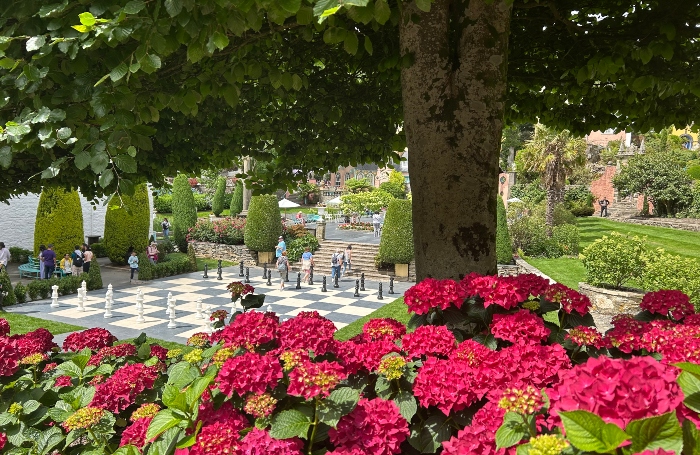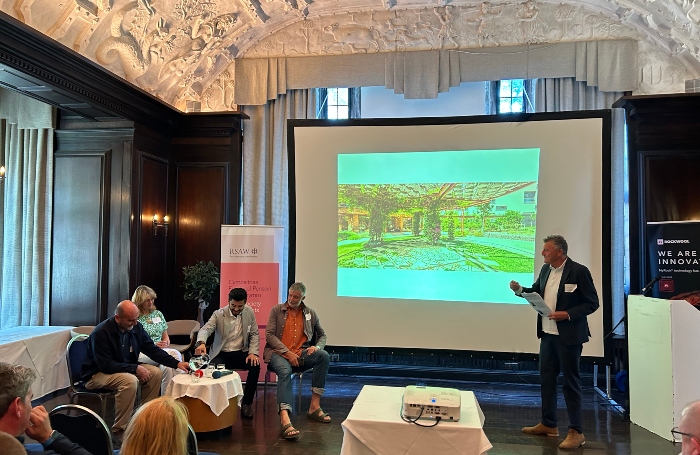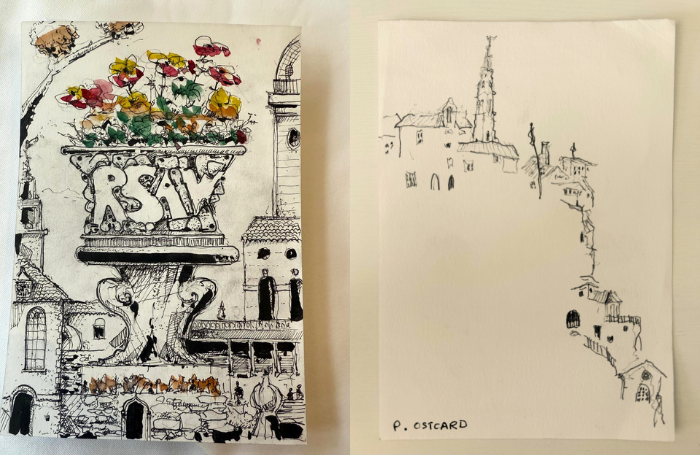On 26 June, around 70 members and guests gathered at Portmeirion for the RSAW Summer conference 2025. The theme, Architectural reverie: Celebrating the power of place, explored how architecture influences - and is influenced by - its location and cultural context.
Returning for the first time since 2019 to Portmeirion, Clough Williams-Ellis’s village and its fusion of Mediterranean and Italianate styles set in a Welsh landscape was the ideal setting to explore the relationship between architecture and the environment, and to discuss how places shape architectural identity, memory, and experience.
We looked at how architecture responds to and enhances its surrounding environment, how architects can create visionary yet ecologically responsible structures that respond to contemporary environmental challenges, and reflected on harmony between the built environment and the natural world.
With this in mind, the programme featured speakers from Barcelona, London, and Bristol, and was chaired by Chris Williamson, RIBA President Elect.
The day began with ‘Touchstone Talks’ – a conversation between Patrick Hannay, Touchstone editor, and Geraint Talfan Davies, Chair of The Cyfarthfa Foundation. The conversation was a chance to reflect on Touchstone’s origins, its purpose, its main achievements, and its place within the architectural community in Wales.
After a coffee break, Peter Barber of Peter Barber Architects, spoke to some of his key projects over the last 30 years in practice, many of which had won RIBA Awards. Specialising in social housing mainly in London, Peter’s work has consistently shown that social housing and those in need can be afforded homes of very high quality.
After lunch at Portmeirion Hotel, Clare Wilks of LDA Design, talked through her practice’s work, with a particular focus on projects undertaken in Wales. Of particular interest to local delegates, LDA’s masterplan for Bangor was met with enthusiasm as it highlighted the need for community engagement for a scheme to reach its full potential.
Following on from Clare, Hamza Shaikh of Gensler, gave delegates a glimpse of the ever-evolving possibilities of AI tools in helping the architect in their work. With the technological advancements seemingly changing every month, Hamza showed how AI tools can add detail and suggest changes to live sketches, and how AI can better help architects to understand their clients.
Rounding off the day, Joan Callís of EMBT Architects, showcased the most significant work of the practice, including the Scottish Parliament completed in 2004. Joan spoke of the design ethos of the practice and how different materials and shapes from nature are both key inspirations in the work that is produced.

Reflections from conference
Chris Williamson, Weston Williamson and Partners; RIBA President Elect said:
“In my presidential campaign, I raised the importance of reinstating the annual conference in order to raise the profile of the Institute and provide an opportunity for important debate and learning. Chairing the RSAW Summer conference 2025 proved to me the importance of this. It was a wonderful event with a collection of great speakers and also contributions from the delegates.
The location - in Clough Williams-Ellis’s Portmeirion - provided a wonderful setting. The conference theme was “The Power of Place” and the speakers covered many common concerns in a variety of ways.
Following the introduction from outgoing RSAW President Dan Benham, there was a conversation between Patrick Hannay and Geraint Talfan Davies. Patrick has been editor of Touchstone magazine for 40 years and has an encyclopaedic knowledge of architecture in Wales. Geraint represented the clients side and both contributed invaluable insights and great knowledge through their various experiences of the Design Council for Wales, Welsh Development Agency, and elsewhere. They provided an expert analysis of what initiatives had really worked over the years and what is less successful .
After coffee Peter Barber took to the stage. I hadn’t heard Peter lecture previously and was as impressed by his passionate presentation as I have been for many years with his work. It was a life affirming talk about the importance of well designed social housing with wonderful examples. After lunch overlooking the amazing coastline Clare Wilks from LDA Design spoke about community engagement referencing two projects in particular in Bangor and St Just.
Hamza Shaikh from Gensler then spoke passionately about AI and the possibilities, opportunities, and threats that generates for designers in the urban realm. It was unsurprising that this important topic generated so much discussion in the panel session. As an alternative Joan Callis showed a more traditional design approach using hand sketches with paper and card models testing out options introjects including Edinburgh, Napels, and Barcelona.
As a student I attended a few RIBA conferences including one in York. I remember being enthused and that buzz of joining a lively engaged profession was a great encouragement to study.
It was wonderful to see so many young architects in the Portmeirion Hall and I hope that had a similar experience to me 40 years later.
The conference was sponsored by Rockwool and Ibstock who both had stands demonstrating their products and services in the adjacent space.
An annual conference will definitely form part of the future plan. Well done RSAW, Dan, Elinor, Bethan, Tom and all the speakers.”
Dennis Hellyar, RSAW Summer conference attendee said:
“The setting and speakers at this year’s RSAW Conference were both inspiring and educational, with a theme of confidence and humility, running throughout. Congratulations to RSAW team for an excellent event”
Clare Wilks, Director at LDA Design said:
“The inspiring village of Portmeirion, Wales was the perfect place to talk about the fortunes and futures of two other towns on the Celtic fringe: Bangor, just up the coast, and St Just in Cornwall. I told the story about how LDA Design has helped local communities to prioritise and pursue successful regeneration plans.
I explained how my previous work as a sculptor has informed my work as an urban designer. For years I designed and handwove large-scale site-specific willow structures in sculpture trails, parks and gardens. My approach in both disciplines is driven by three core themes: understanding place, working collaboratively and radical incrementalism.
I loved discovering synergies with several other speakers at the RSAW conference. While we are all very different, working collaboratively came through strongly, and using a range of artistic techniques. Peter Barbour starts a project with layers of hand drawings and handmade 3D models (many of which are displayed in his studio’s shop window in King’s Cross) and, for Joan Callis at EMBT, creating handmade collages are a key part of his design process. Hamza Shaikh shared his experiments taking his hand drawings into AI technology to develop ideas into unimaginable structures.
However technology evolves, there will always be a place for people to sit together and talk things through in both conferences and community consultations.”

Mid Wales Branch dinner
The Mid Wales Branch secured RIBA Local Initiative Funding (LIF) to host the dinner, following the conference. It was a fantastic opportunity to bring together local members to connect, reflect, and celebrate architecture in Wales. Tom Nancollas, author and design expert, delivered a memorable talk on 'How to build a folly', exploring how follies inspire reverie, celebrate place, and bring creativity and joy to planning in modern Britain.
Postcard competition brief winners
We invited delegates and speakers to create a picture postcard as part of the conference sketching competition. They were able to use any medium that comes to hand and the entries were judged during the drinks receptions of the Mid Wales Branch dinner.
We are pleased to congratulate the winner of the competition, Oliver O'Neill, Architect at Hughes Architects and the runner up, Isaac Shepherd, Architectural Assistant at Jon James Studio Architecture:




